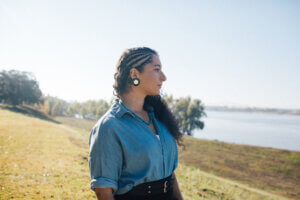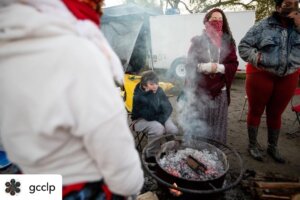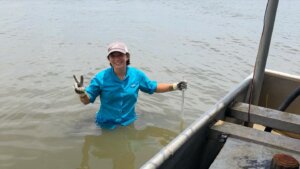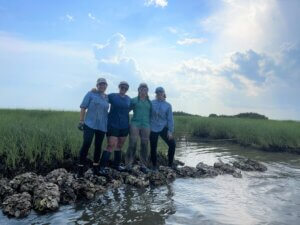Maferefún eégún – me lᴐ wo. Yakoke chitto yakni hokulbi, ʋni nashoba, sʋpokni Lois Jones cha Annie Roque, sʋshki Angellar, a tek Erin, umafo John Coy cha James, aki Michael, a nafki Austin, cha Okla Hina Ikhish Holo. Mo pele Kellyn LaCour-Conant et mo lestoma cé pa gardemangé. [Translation at end]
What drew you to study ecology and conservation?
I’ve always felt comfortable in nature and drawn to wildlife, even when I was little. I grew up in Houston, but my family is from the Kisatchie Forest area in central Louisiana, descended from the Ewe and Fon tribes of West Africa, the Choctaw, Caddo, and Apalachee, ancestors from China by way of Cuba, and also the French and Spanish who all melded here in colonial Louisiana. The Cane River Creole people, free people of color, mixed Black Native folks created a community for themselves in the foothills of Kisatchie. Some of my fondest childhood memories are spending summers swimming in the river, riding through the fields of the old family farm, fishing and crabbing along the Gulf, and climbing a lot of trees.
Before colonization, it was fairly common for Indigenous people to have seasonal homes, to fish seasonally on the coast, and then move more inland for safety during hurricane season and to hunt other game. Growing up between Houston and central Louisiana and going back to the village where my family’s from, that’s my modern Indigeneity, especially as someone who is mixed race, not an enrolled member of a federal tribe, and who currently lives in an urban setting.
I wanted to go to college thinking I’d study anthropology or journalism because I wanted to fix or raise awareness of the big social problems that we have. I never thought I could have a career working with nature, and then it finally clicked and I realized, “Oh, this is what I’m meant to do.” I was called to work with nature.
I pursued a bachelor’s degree in Biology, worked as a prescribed fire technician, as a preserve steward, and I went on to get a Master’s in Marine and Environmental Biology. I worked for the State of Louisiana for a while, for the Coastal Protection and Restoration Authority. I left that job to pursue something that was healthier for me, and moved into the non-profit world to run community farms and advance food security in the Baton Rouge area. But the coast called me back and I’m now proud to be serving as Director of Restoration Programs with the Coalition to Restore Coastal Louisiana. I’m also working on my Ph.D. in Urban Forestry at Southern University, and I work as a youth mentor with the AAAS If/Then program as well as with local groups like the Baton Rouge Youth Coalition.
You said you felt “called” to work with nature—what do you mean by that?
“As I explored biology, it actually cemented my faith that the comfort and the spirit that I feel when I’m out in nature is part of a bigger force and a higher power.”
I think most of us are looking for a purpose. Why are we doing all these things that we do? Why labor? Why live? I have always felt most comfortable in nature; it was always a place of reflection and safety. When things weren’t going right at home or at school, I’d go walk along the creek or I’d go climb a tree. My family are traditionally planters, trappers, and horse people. Our matriarch was well skilled in plant medicine; that’s just something common in our family tree and that was very present in my upbringing.
I sought out conservation volunteer opportunities when I was younger thinking it’d be fun; it was what piqued my interest, and it just felt so rewarding and so wonderful to work with injured birds or to create seed balls with younger students. I didn’t think it could be a job because it was too perfect and I wanted to do it all the time. As I researched career opportunities and talked to folks who actually do this type of work, I started thinking, “You are given this background, and this skill, and this interest, why wouldn’t you provide for yourself this way?” And it’s not just a job; I have that passion and that history, and that strengthens the work that I’m able to do. So whether I’m working on the coast or in a forested habitat or advancing food security through native plants and urban habitat restoration, it’s working with people and our environment and trying to build healthier relationships between them. It’s an extension of a healing modality that just feels right.
How does spirituality inform your identity?

Taken at Scott’s Bluff overlooking the Mississippi River on the Southern University campus in Baton Rouge. Credit: Akasha Rabut/ Ripple Effect Water Literacy Project.
I was raised Catholic, but even from an early age, it didn’t sit right with me. I remember being in elementary school and saying, I don’t want go into church because of the Crusades and the Inquisition and knowing these legacies of violence. It just didn’t feel right for me; I wondered how we could support a faith that is built on so much conquest and pain. And the role of patriarchy in the Christian church never sat right with me. There are some things in Catholicism that are comforting to me, like the rosary and the community, and certain rituals and honoring our dead and our ancestors on All Saints’ Day and All Souls’ Day. But the history of it never sat right with me. But it was so taboo to not be Catholic, to not go to church, to not go to mass. I connected with folks who felt similar to me, and reconnected with some elders who were carrying on ancestral traditions in our family, even though many people had deemed them not important anymore. I was finding those people in our family who were interested in revitalizing some aspects of our ancestral traditions before Christianity.
Going into college, I identified as an atheist or agnostic. Even though I thought nature was the most spiritual experience, seeing all the suffering and abuse in our society, I didn’t have a lot of faith that there was something bigger than that. But as I explored biology, it actually cemented my faith that the comfort and the spirit that I feel when I’m out in nature is part of a bigger force and a higher power. And all of us are part of it, too. Learning about entropy, and how energy is neither created or destroyed, and understanding the intricacies of the human body, and studying ecology—the deeper that I got into science, the more faith I had.
And it’s not that I’m some rogue Catholic. It’s realizing that the things that I was always called to do are actually part of a larger tradition and ceremony. I’ve been fortunate enough to connect with elders who come from similar backgrounds of growing up in Black Christian communities, or mixed Afro-Indigenous Catholic communities, or Baptist Native churches. And these elders realize that our connection with Christianity has been really fraught with violence, and that there’s a lot of power in us remembering the spiritual practices that came before that.
“The land and water and atmosphere are our oldest ancestors….[They deserve] all of our respect and a very deferential approach to stewardship. We aren’t the masters of this land; we are children of this land who are here to care for our elder.”
How do you integrate your Indigenous knowledge and spirituality into your conservation philosophy?
Indigenous people are so diverse, and I can only speak to my heritage, my people, and my experience. I think for most people who identify as Indigenous, it stems from a shared ancestral connection, not just with our human ancestors, but the land that we live on. There’s a concept of kin-centric ecology; instead of looking at water, plants, trees, and animals as separate, inanimate natural resources, they are living, spirit-imbued beings. They deserve the sort of respect that you would offer your brother or neighbor. And that changes how you engage in your science and research and what you prioritize.
In my work, my Indigenous knowledge offers added respect for the land and the water; they’re not something to be controlled or managed or dissected. The land and water and atmosphere are our oldest ancestors, the source of our people. A lot of Louisiana and Texas Indigenous creation stories stem from us coming out of the water, out of the coast or mud or mounds. You can’t just flippantly disregard these monuments or the land or the water. It’s a different perspective from what you typically get in conservation. We’re not talking about a disembodied, disconnected hunk of soil—this is our ancestor; it deserves all of our respect and a very deferential approach to stewardship. We aren’t the masters of this land; we are children of this land who are here to care for our elder.

Taken Winter Solstice 2020 in Venice, LA during the Sacred Waters Pilgrimage. Credit: Gulf Coast Center for Law and Policy.
It’s impossible for me to engage in environmental work without acknowledging that we derive our life from the land, water, plants, and everything that we live with, and that they are our family that deserves our respect. And you can see parallels in how some people in this field disrespect the environment by talking about it in a detached manner and very unlovingly, and how they engage with community members who might not be scientists. It’s really silly to think that just because you know all the rocks and you did a degree in whatever, that you can now come to a fisherman whose family has fished these waters for generations, and think you inherently have a deeper understanding of the issue than he does because you have letters after your name. I want to extend that same empathy and compassion that I feel for my environment to all of my neighbors and all of my relations.
As I mentioned, there are a lot of Indigenous people, and we are living in modern times. Our indigeneity and our traditions are not stagnant—they’ve been updated and adapted to meet the needs of our people. I think some folks in conservation have this mindset that we have to keep the coast or the habitat in a certain way, like “Let’s go back to this pre-colonization era.” And that is a broken way of looking at conservation because you’re trying to control time and land. Our society tends to treat land and water in similar ways to how it treats tribal nations and Indigenous people: by trying to box them in. Our restoration efforts have to be dynamic. Restoration is a relationship, not an end goal.
Have there been particular instances when your Indigenous worldview impacted the practice of your work?
One example is my work in food security. It still blows my mind that organizations sometimes have to lease public park land to run an urban farm. It’s just strange that there are mass public landholders that only give people limited access to the land. It feels so false to have to pay an entry fee to go to a national forest when our people were living on and with this forest for centuries, generations, millennia before the National Park Service even existed.
When working with land and establishing farms or community spaces, I always think about how we can go a step further. How can we do more than just having a community park or farm that’s accessible to local residents, more than giving them the tools to grow pots of peppers on their apartment balcony? How can this be a step toward more land sovereignty and giving people access to land to grow their own food on? You can’t talk about food security if you don’t talk about restrictions on mobility, land access, and homeownership.
“Restoration should include language, land rights, and liberation…People are not separate from their environment; we are part of the same being. If you’re not also concerned with restoring people and human communities, then you’re not really doing everything you can to restore the environment.”
Another example is from when I was involved with the Sacred Waters Pilgrimage in 2020. That was a movement organized by the Gulf Coast Center for Law & Policy and the United Houma Nation, as well as a spiritual collective of women called the Wind & Warrior Collective. We were mostly working with West African traditional ceremony, as well as Southern Black and Indigenous tradition. The movement lasted from summer solstice to winter solstice. We started in Minnesota at the headwaters of the Mississippi, and made our way down to the Delta doing both in-person and virtual programming every full moon. We would hold a traditional water ceremony to heal ourselves and to heal the waters of the Mississippi.
We’d also educate each other about the state of our watershed and what we can do day to day to improve the health of both our watershed and the people who are affected by it. When you’re so connected to the land and water, the harm done to them affects us all. And the movement provided space for Black and Native women and Two-Spirit people to feel and heal in a very protected space of our own. It’s no surprise that suicide rates are so high in Indigenous communities and that we know so much trauma and violence; that fact can’t be disconnected from the exploitative harm that humans force on the environment. The movement provided space for our communities to heal each other, to educate each other, and to honor the river watershed, and that was really powerful and touched a lot of folks.
Can you tell us more about what you mean by “Two-Spirit?”
Two-Spirit is a pan-Indian umbrella term; it’s not specific to any tribe. It was adopted a couple of decades ago at an Indigenous conference to represent the unique experience of some people who are on the LGBTQ spectrum and also hold Indigenous identity. Indigenous folks can be lesbian or gay or bi without identifying as Two-Spirit, but if you’re Two-Spirit specifically, you’re a bit of a mediator or a translator to the people in your community. You are tasked by your community and your ancestors to be a spiritual leader in certain ways.

Taken July 2021 during deployment of latest living shoreline in Plaquemines Parish. Photo credit: CRCL.
For a lot of people who identify as Two-Spirit, you always feel like you’re in this liminal space. Like, “I’m a little bit in this community, I’m a little bit over here,” or “I’m a little bit in the spirit world, I’m a little bit in the physical plane.” Growing up, I had very vivid dreams, and could recount details about things I couldn’t have known. As I got older, I found my role within my family and community and profession. I identify as pansexual as well. And looking at it all, it just started making sense that I was Two-Spirit. I felt that I have these dreams and skills and passions, and this ability and role within my family because I’m here to translate something for us or to help us see in a different way.
The concept of what we call Two-Spirit isn’t unique to the Delta region or even North America. There are different terms for the same person and community role in West Africa. Some people use the name “gatekeeper.” Often, our people were called on to lead ceremony or to provide comfort or healing. I mentioned earlier how I view restoration ecology as a healing practice; you’re literally restoring and healing the environment and trying to create a healthier place for all of us to live. And I’m still translating day-to-day; the folks in this field who don’t have empathy for the land, we’re trying to get them to listen.
Why is it important to consider cultural and historical perspectives when working on conservation or restoration?
Restoration should include language, land rights, and liberation. If you focus only on treating the symptom and not looking at the cause, you’re going to perpetuate an exploitative relationship with your environment. We have to look at when Indigenous people had circular economies and a kin-centric relationship with our ancestral land who is our elder, and when we lived in a way that respected the natural cycles. If you don’t look at when that tradition was destroyed, then you’re not really getting at the root of why we experience a lot of the environmental damage we have today. We have this take, destroy, waste, repeat industrial lifestyle, and we’re just perpetuating the same violence. So, how can you not include cultural perspectives and environmental justice and historical violence in this conversation about restoration? People are not separate from their environment; we are part of the same being. If you’re not also concerned with restoring people and human communities, then you’re not really doing everything you can to restore the environment.
What suggestions do you have for scientists who are new to local conservation and environmental justice work?

This reef will protect an Indigenous mound complex traditionally stewarded by the Atakapa-Ishak/Chawasha community of Grand Bayou Village. Photo credit: CRCL.
Don’t underestimate people or communities. There are a lot of people who will come into a community and be very condescending. There are also people who have good intentions and think that they just need to “educate” people. Education can be part of it, but with that mentality alone, you’re making the false assumption that you have all the answers and that you just need to give them to the community. It should always be an exchange; you may have resources or skills that you can offer the community as a service, but more often than not, they have a lot to teach you as well.
Be humble and look at yourself as a resource for them. Don’t tell them what they need to do or what you’re going to do for them. Ask what they need, how you can help, and be willing to learn.
Translation of Kellyn’s greeting, a mix of Yoruba, Ewe, Choctaw, and Louisiana Creole: Honor, blessings, and love to our ancestors. Many thanks to the wetlands and the wolfberry, to my grandmothers Lois Jones and Annie Roque, my mother Angellar, my sister Erin, to my grandfathers John Coy and James, my father Michael, my brother Austin, and to the People of the Sacred Medicine Trail. My name is Kellyn LaCour-Conant, and this is what I have to say.





